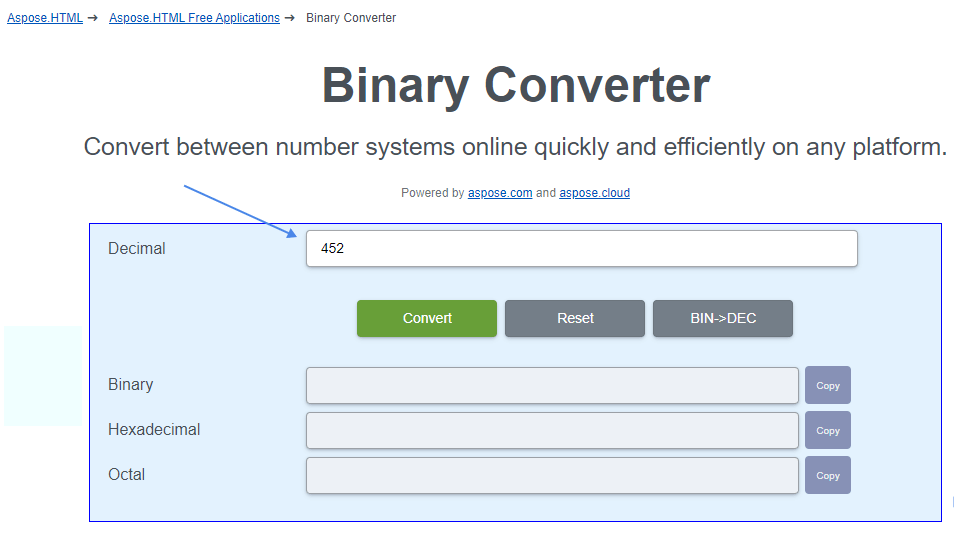
Binary converter
Created on 7 October, 2024 • Converter Tools • 96 views • 3 minutes read
Binary Converter: Simplify Your Number Conversions
A binary converter is an essential tool used to convert numbers from binary to decimal, hexadecimal, and other number systems, or vice versa. This tool is widely used by programmers, computer engineers, and anyone dealing with digital systems. In this article, we’ll explore the basics of binary numbers, how to use a binary converter, and why it’s useful.
What Is a Binary Converter?
A binary converter is a digital tool that allows users to convert numbers between the binary system (base 2) and other numerical systems like decimal (base 10), hexadecimal (base 16), and octal (base 8). The binary system uses only two digits, 0 and 1, which are crucial for computers and digital systems.
Common Number Systems Used in Conversions
- Binary (Base 2): Only uses 0 and 1 (e.g., 1011).
- Decimal (Base 10): The most commonly used system with digits from 0 to 9 (e.g., 11).
- Hexadecimal (Base 16): Uses digits 0-9 and letters A-F (e.g., B).
- Octal (Base 8): Uses digits from 0 to 7 (e.g., 13).
Why Use a Binary Converter?
1. Easier Understanding of Digital Systems
Binary numbers are the foundation of digital computing. A binary converter helps to translate these numbers into formats humans commonly use, like decimal and hexadecimal, making it easier to understand and work with digital data.
2. Useful for Programming
In programming and computer science, binary is used frequently. Programmers often convert between binary and hexadecimal for tasks such as setting memory addresses or working with machine code. A binary converter simplifies this process.
3. Quick and Accurate Conversions
Manually converting binary numbers into decimal or other formats can be error-prone and time-consuming. A binary converter automates this process, ensuring fast and accurate results every time.
How to Use a Binary Converter
Using a binary converter is straightforward. Whether you're converting binary to decimal or hexadecimal to binary, the steps are simple:
1. Convert Binary to Decimal
To convert a binary number like 1011 into decimal:
- Enter the binary number into the converter.
- The tool will convert the binary 1011 to the decimal equivalent 11.
2. Convert Decimal to Binary
To convert a decimal number like 11 into binary:
- Input the decimal number into the converter.
- The converter will return the binary equivalent, which is 1011.
3. Convert Binary to Hexadecimal
To convert binary 1011 to hexadecimal:
- Enter the binary number in the converter.
- The converter will return the hexadecimal result, which is B.
Benefits of Using a Binary Converter
1. Speed and Efficiency
A binary converter allows you to quickly convert numbers without needing to understand the complex mathematics behind it. This speeds up tasks and enhances productivity, especially for professionals working with large amounts of data.
2. Reduces Errors
Manual conversions can result in mistakes, particularly when working with long binary numbers. A binary converter ensures that all conversions are precise, eliminating the risk of human error.
3. Versatility Across Systems
With support for binary, decimal, hexadecimal, and octal conversions, a binary converter provides versatility, making it easy to work across different platforms and systems.
Common Applications of a Binary Converter
1. Digital Electronics
Engineers and electronics enthusiasts use binary converters to simplify calculations and analyze binary data when working with hardware, such as microcontrollers and memory systems.
2. Networking
Binary numbers play a significant role in networking, particularly in IP addressing and subnet calculations. A binary converter helps professionals easily switch between binary and decimal systems to understand or configure network settings.
3. Programming and Software Development
Many programming languages use binary, hexadecimal, and octal representations. For instance, developers frequently convert binary data into other formats to debug or optimize their code. A binary converter assists in ensuring that these values are correct.
Best Online Binary Converters
Several online binary converters offer precise and efficient number conversions:
1. RapidTables
RapidTables is a popular tool that offers quick and easy binary conversions to decimal, hexadecimal, and octal, all in one place.
2. CalculatorSoup
CalculatorSoup provides a versatile binary converter with additional functionality, such as converting binary floating-point numbers to decimal.
3. BinaryHexConverter
BinaryHexConverter is a user-friendly tool that specializes in binary-to-hexadecimal and binary-to-decimal conversions, making it perfect for developers and engineers.
How to Choose the Right Binary Converter
When selecting a binary converter, keep the following in mind:
- Ease of Use: Choose a tool that has a simple, user-friendly interface.
- Accuracy: Make sure the converter is reliable and produces accurate results.
- Range of Conversions: A good binary converter should support multiple formats, including decimal, hexadecimal, and octal.
Conclusion
A binary converter is a must-have tool for anyone dealing with digital systems, programming, or networking. It simplifies the process of converting numbers between binary, decimal, and hexadecimal, ensuring accuracy and saving time. Whether you’re an engineer, developer, or student, using a binary converter can enhance your efficiency and make complex conversions easier to understand.
Popular posts
-
Ascii converterConverter Tools • 116 views
-
Hex converterConverter Tools • 106 views
-
Binary converterConverter Tools • 95 views
-
Case converterText Tools • 92 views
-
DNS LookupChecker Tools • 91 views